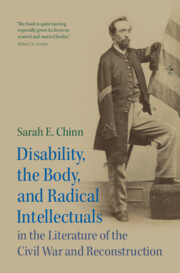Book contents
- Disability, the Body, and Radical Intellectuals in the Literature of the Civil War and Reconstruction
- Cambridge Studies in American Literature and Culture
- Disability, the Body, and Radical Intellectuals in the Literature of the Civil War and Reconstruction
- Copyright page
- Dedication
- Contents
- Figures
- Acknowledgments
- Introduction
- Chapter 1 Giving Up the Ghost
- Chapter 2 “Strewn promiscuously about”
- Chapter 3 1860 or 1865? Amending the National Body
- Chapter 4 “I don’t care a rag for ‘the Union as it was’”
- Chapter 5 Shaking Hands
- Conclusion
- Notes
- Bibliography
- Index
- Recent books in this series (continued from page ii)
Chapter 1 - Giving Up the Ghost
The Dead Child versus the Amputated Limb
Published online by Cambridge University Press: aN Invalid Date NaN
- Disability, the Body, and Radical Intellectuals in the Literature of the Civil War and Reconstruction
- Cambridge Studies in American Literature and Culture
- Disability, the Body, and Radical Intellectuals in the Literature of the Civil War and Reconstruction
- Copyright page
- Dedication
- Contents
- Figures
- Acknowledgments
- Introduction
- Chapter 1 Giving Up the Ghost
- Chapter 2 “Strewn promiscuously about”
- Chapter 3 1860 or 1865? Amending the National Body
- Chapter 4 “I don’t care a rag for ‘the Union as it was’”
- Chapter 5 Shaking Hands
- Conclusion
- Notes
- Bibliography
- Index
- Recent books in this series (continued from page ii)
Summary
Chapter 1 traces the antebellum faith in the non-finality of death and its antithesis in the irreparable change wrought by amputation. In sentimental theology, the dead are never wholly gone – they live on to inspire and save, awaiting reunion with those they leave behind. The dead child embodies the reality of unpredictability and at the same time operates within a narrative that soothes. The author contrasts antebellum postmortem photography and images of amputees and amputated limbs. Postmortem photography of children reinforces the sense that the family has not really been ruptured, that death isn’t really the end. Photographs of amputee Civil War soldiers do quite the opposite. Rather than operating as postmortem photography does, as a mediator between the living child, its dead body, and the family left behind, the portrait of the amputee is insistently in the present, even as the lost limb is consigned to an unrecuperable past. While nineteenth-century pictures of dead children often encouraged the fiction that the photograph’s subject was an ongoing member of the family, amputation photography – both medical and vernacular – insists on the permanence of bodily change.
- Type
- Chapter
- Information
- Disability, the Body, and Radical Intellectuals in the Literature of the Civil War and Reconstruction , pp. 31 - 70Publisher: Cambridge University PressPrint publication year: 2024



